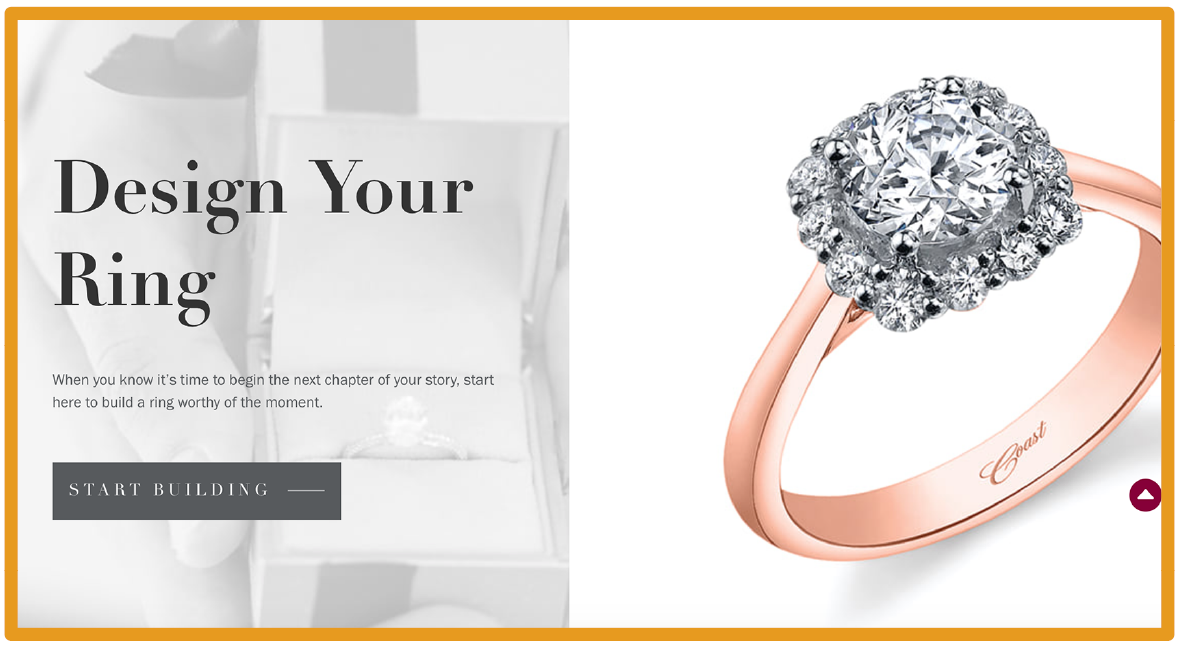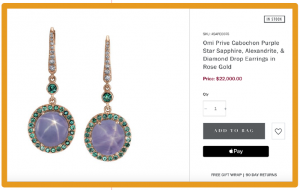E-commerce has been vilified by many independent retail jewelers as an under-cutting, price-conscious evil entity intent on stealing hard-earned business from brick-and-mortar stores while ripping their profit margins to shreds.
At this point, though, it’s more or less a matter of if you can’t beat them the way you’ve been operating, you’d better consider joining them.
It’s time to rethink e-commerce as a viable option for you, the independent brick-and-mortar-based jeweler, but also to understand what it takes in dollars and time to drive traffic to a website, says Ben Smithee, digital-marketing expert and CEO of The Smithee Group. The big online players didn’t get where they are without investing considerable time and money into marketing, social media and search-engine optimization.
In other words, simply enabling e-commerce is not like flipping a switch and watching the money pour in. Instead, imagine you’re opening a second store. How much planning and preparation would you put into that? You’d work with a store designer. You’d hire more staff. You’d invest in advertising.
“Most people grossly underestimate what it takes for advertising to send people to the site,” Smithee says. “A lot of them expect to have overnight sales. Start with realistic expectations — they should be thinking about selling one, two, three things a week or a month to start and ramping up from there. Without realistic expectations, they will decide it doesn’t work and will quit,” Smithee says.
Independent jewelers like Tim Wright of Simply Unique Jewelry Designs in Yorktown, VA, have been reluctant converts in recent years. Wright says he realized in the past year that his company has to be searchable and sell its wares online. If not, he says, “We will go away like other independents in our area.”

It took time for Wright to wrap his head around the idea. “I cannot imagine people ordering jewelry, especially our one-of-a-kind pieces, off the Internet, but we are working on a new website to be more searchable and to be able to sell off of it. The basics we all have survived on over the years are not selling in the store anymore because of the Internet.”
Shane O’Neill, vice-president of Fruchtman Marketing, advises independent jewelers to temper their expectations when they turn to e-commerce.
Most jewelers are not going to see significant amounts of e-commerce, he says, because the marketing perspective is much different between traditional stores and online stores. “If they are marketing around a 20-mile radius, we still know that people want to touch and feel the jewelry,” says O’Neill. Plus the data that millennials don’t shop in stores isn’t necessarily true. They shop in bigger numbers than Gen X or baby boomers do. But they shop online with the idea of browsing and checking out pricing, and so they expect a shopping experience with all of the details revealed, O’Neill says.
Advertisement
The preparation it takes to be ready for e-commerce almost certainly will result in increased sales in the store.
“They probably have checked all the boxes in terms of a good user experience, descriptions, photos, categories of metal type and have galleries of multiple products,” O’Neill says. “When someone comes to the website and they have the ability to have a great browsing experience, they make purchasing decisions based on that. When they stop in the store, you should have a higher closing rate. To me, that’s an e-commerce transaction, too.”
The website should be like your second store, O’Neill says, in terms of how you relate to the customer online: “How you flow people through your site is like what a sales associate does in the store.”
For Janne Etz of Contemporary Concepts in Cocoa, FL, e-commerce has grown steadily over the past two years from 35 percent of her business to a solid 50 percent. “You have to pay serious attention to it,” she says. “It is not a set-it-and-forget-it operation. What works with e-commerce this month will evolve into something else next month. It’s a constant learning process. I continue to study and learn and implement the newest techniques, so I can continue to grow!”
Stephenie Bjorkman of Sami Fine Jewelry in Fountain Hills, AZ, says an e-commerce-enabled website seems like a huge project, and it can be. But start somewhere, she says. “Just do it, or just do something,” she says. “Get ready to flip that switch. Take on little bits and pieces at a time and set goals. I am so far from anywhere near where I want to be, but my marketing department and I sat down and made a monthly calendar so that we could plan all of our marketing, social media, blogs etc.” Bjorkman’s team also worked on posting pieces for sale in groups of 24 at a time.
If even this seems like too much, start with making time for your own social media. Friend your top 100 clients and start from there.
“I think you need to make a plan, then work your plan,” Bjorkman says. “You can begin by doing this in the evening when you get home. Or have one of your employees spend an hour a day on it. The first step is that every day you should be posting on social media. Post real pictures and start creating your online image. Connect your posts to your website and tell them how to buy.”

Borsheims
E-Commerce Continues to Evolve in an Omni-Channel World
Borsheims of Omaha, NE, has been selling online since 1998 and today has seven associates dedicated to e-commerce.
“We’ve seen tremendous growth in the channel,” says Adrienne Fay, director of marketing and business sales — a 40 percent increase year over year in online sales for the past two years. This year that trend continued with a huge lift in January and February. The e-commerce staff is involved in navigation, digital photography, answering questions and virtually holding hands as needed. They also fulfill the orders — 99.9 percent of the inventory is in the store already.
 In March 2018, the company introduced a new website that made online purchases easier on all devices, while updating their ring-builder tool to make it both more user-friendly and more luxurious-looking, says Andrew Brabec, director of e-commerce. “A lot of our customers will utilize their mobile device first and then make a purchase on their desktop. They prefer the process on the mobile device; it’s easier, faster.” Chat is used more than ever by customers looking for a promo code or to ask a quick question, but few purchases take much hand-holding.
In March 2018, the company introduced a new website that made online purchases easier on all devices, while updating their ring-builder tool to make it both more user-friendly and more luxurious-looking, says Andrew Brabec, director of e-commerce. “A lot of our customers will utilize their mobile device first and then make a purchase on their desktop. They prefer the process on the mobile device; it’s easier, faster.” Chat is used more than ever by customers looking for a promo code or to ask a quick question, but few purchases take much hand-holding.
One reason for that is that the new website is designed to anticipate questions that shoppers might have. Photographing jewelry items next to coins, for example, allows customers to gauge the size of the piece quickly and easily. “The main questions we get are: What size is this? And how does it look on someone?” Brabec says. One goal is to provide more views of each product.
“We try to replicate our customer service online,” says Fay. “It’s a strategic investment. We look at shoppers in an omni-channel fashion. Not as an e-commerce customer, not as a store customer. Simply a customer. We want to be able to knock their socks off in all channels.”
Shoppers who convert to online sales represent a wide demographic — established customers, gift shoppers, fine jewelry shoppers. Average order fluctuates, but recently it was $263. “We definitely have sold items that retail in the tens of thousands. Not every day, but it’s not unusual,” Fay says. Customers log in from all over the U.S. and the world; international checkout is available with exact pricing.
What’s next? Borsheims is testing out products to provide shoppers with 360-degree views of products, a technology that is increasingly common in other industries. Another huge goal is to get 97 percent of their products visible online; currently that number is about 74 percent. “We want to see more items in the cart, too, so we’re working on ways to up-sell in the cart by showing related products,” Brabec says. “In addition, we are going to evaluate pages to make them faster and more effective.”
The year 2020 represents Borsheims 150th anniversary. “And you don’t survive that long if you don’t evolve and grow and roll with the punches,” Fay says. “We used to say we at Borsheims are going to tell you as customers what you need to buy. Now we respond to what they are looking for with content and expertise and education.”
Advertisement
Ringcrush
Growing Fast on Etsy
Bailey Lehrer founded Ringcrush, a start-up online jewelry store, selling $30 to $60 jewelry items on Etsy. She started the business with $700 and turned a profit immediately.
“We were able to grow in two years really quickly,” Lehrer says. “I did a little under $1 million on Etsy and another $300,000 on Amazon. It made sense for me to start up online. Etsy is really friendly to people who want to experiment.”
Lehrer says that while high-end diamond solitaires aren’t the norm on Etsy, moissanite rings are moving fast, as are other non-traditional types of diamond engagement rings, usually with an artisan design or a unique setting. “Etsy is primarily for 25- to 35-year-old women,” she says. “A lot of them still want that look and they can swap out the stone later. One of the most popular rings looks like a hand-carved band with a diamond solitaire in the center.”

Bailey Lehrer, founder of Ringcrush
The process of opening a shop on Etsy is easy, Lehrer says, because they hold your hand through the whole process. Still, there’s more to it than just opening. “You have to understand your competition and price point. It can be cutthroat with common items, and there are people from other countries selling items with razor-thin margins. You need something unique. That way you can raise your price.”
Her point of differentiation is pieces of raw gemstones. “So I still focus on precious stones like emerald and sapphire, but I’m able to sell them at $60 because I get them uncut. They’re still blue if it’s a sapphire; still green if it’s emerald. It’s kind of a unique aesthetic, so it’s easy to stand out.”
Another thing to keep in mind, Lehrer says, is that there is clear evidence shoppers will convert to making a purchase if the product is photographed on a white background. “Know how to take great pictures,” she says.
Advertisement
Mullen Bros.
They Want to Be Your Local Jeweler, No Matter Where You Are
Bob Mullen is owner and founder of Digital Jewelers Academy, as well as an owner of the family business, Mullen Bros. Jewelers in Swansea, MA.
For several years, Mullen and his family pondered the “what ifs” and the concerns they imagined would come with e-commerce while they experimented with product catalogs on their website. “What about stock? What about if we sell things that are sold out? What about fraud? But it’s like having children: If you wait till you’re ready, you’re never going to do it.” In 2014, they began selling online through Shopify and realized $100,000 in revenue the first year.
“In terms of problems, the same things that I thought in my mind would be problems DID happen, but it was not that big of a deal to overcome them. In terms of inventory, it was about keeping things on the site that would be accessible and in stock, unless it’s something like bridal. We only work with designers who have products available that we can get quickly.
“Like anything else, there is no one thing that made it happen. It’s like Jim Collins wrote in the book Good To Great. You build momentum, and it gets easier and easier. It’s the trial and error of learning our audience, learning what they respond to, and looking at Google Analytics.”

Now Mullen, a marketing major in college, is working with other retailers on e-commerce goals. Digital Jewelers Academy, in partnership with Gemsone, administers a private Facebook group with instructional videos and an online posting service. “It’s about e-commerce, creating engaging content, Facebook ads, email strategy, website conversion.”
How much time does e-commerce take? “If you’re budgeting 10 to 15 hours a week of someone’s time, you can make a lot of progress if you know what you’re doing. You can be much more efficient in three hours knowing what you’re doing than 10 hours wandering around.”

Bob Mullen, owner and founder of Digital Jewelers Academy
“The No. 1 question I’m asked is regarding differences in inventory and pricing between the website and physical store. A lot of jewelers feel like they should treat the website like a separate store with lower prices to attract business. But unless you’re trying to build a nine-figure company, you should target a customer most like your own.
Mullen’s average ticket online is around $600, which is higher than in his store. “Our biggest sale was $17,000 and it goes down to $99 here and there. The sweet spot, like anything in jewelry sales, is $200 or $300. But the idea that people are just going online and plunking down 10 grand is a myth.”
The key to success is to provide the same level of service you do in your store. “In my opinion, I can service people a lot better than whoever is manning the call center at Blue Nile,” says Mullen. “You can sell an engagement ring in 10 minutes or have multiple visits over four hours in the store; online, it might take three to six emails. It’s about being proactive and being prompt about responding when people email.”
Local limits mean little when it comes to e-commerce, Mullen contends. “People respond nationally to the same things people respond to locally. Our industry loses 1,000 stores a year. When their jeweler closes, people have to go online or find another local store. More and more people are going online as a result, and are happy to work with a local jeweler, wherever you are. Meet them where they are.”
Advertisement

SAMI’S FINE JEWELRY
“We Are Definitely on Our Way to Our Goal”
Last year, Stephenie Bjorkman of Sami’s Fine Jewelry decided that her website and online sales needed to be a priority. But she also knew it was tough, if not impossible, to find time to own the store, work with vendors, manage employees, pay bills, oversee marketing and launch e-commerce.
So she hired one person and then a second person to make it happen.

Stephenie Bjorkman of Sami’s Fine Jewelry
“The only way I could do this was to have a dedicated person to take pics, write descriptions, update events, blogs, social media and more. What is really scary is that I see such an importance in this job, I have already hired her an assistant.”
It hasn’t necessarily “worked” just yet, says Bjorkman. But it is working. “Since I hired devoted staff members, I have seen a 30 percent increase in online sales, along with tons of daily mentions in the store. All of this proves that in the end, having a marketing person is well worth it.”
Online, Bjorkman sells branded items, including her own Animal Rockz line, a custom sterling-silver line of jewelry available in 38 different pet breed varieties. “My store is full of animal lovers, so this is easy for us to be passionate about. We seem to sell at least one of these a day. Prices range from $35-$60 plus shipping. The magic numbers seem to be in the $250-$500 average range. But, with that said, I sold a $30,000 diamond off my website and a $25,000 estate diamond from my e-blast.”
Sales are considered and tracked as “online sales” if everything is done online.
“If you do sell it 100 percent online, you need to handle them like any other client. Answer quickly, make them feel special. We do chat by phone, by social media messengers, text them, and even send them videos. It is a lot of work, but the good news is that it works.
“Our e-commerce actual sales do not currently represent a large amount of my overall business. A two-year goal for me is to sell as much as having a second store. E-commerce also represents the best type of marketing you can do for your business. Long before you advertise in a newspaper, magazine, etc., you should take time to do your online marketing, social media, e-blasts and blogs.”